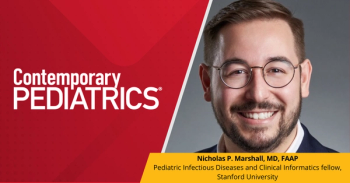
Artificial intelligence enters pediatric practice
Artificial intelligence (AI) is used to make everyday life easier. Here's how AI systems can help elevate your medical game.
Artificial intelligence (AI) is responsible for driving autonomous vehicles, powering intelligent assistants such as Alexa and Siri, and placing annoying advertisements on web pages. AI has also improved many aspects of pediatric medicine, and played an important role in the COVID-19 pandemic.
AI in medicine
Voice recognition/dictation software is an example of AI that is currently used in pediatric practice. Today, Dragon Medical One from Nuance Communications, the most widely used voice recognition medical software, boasts a vocabulary of 300,000 words and integrates vocabularies for 90 medical specialties. By integrating deep learning (DL), the software covers the nuances of the user’s speech patterns and improves over time, achieving 99% accuracy.1
Over the past few years, Nuance developed and perfected a powerful AI-powered virtual scribe system called the Dragon Ambient eXperience (DAX).2 Using a smartphone alone or with a wall-mounted camera and microphone system, the AI system records the entire patient visit and uploads the information to the cloud. The information is analyzed and a complete note is written, which Nuance technicians vet before it is inserted into the electronic health record (EHR) for the provider’s review and signature. The entire process takes 4 hours or less. Currently, DAX is available for use in outpatient clinics by specialists and primary care physicians, including pediatricians. It soon will be expanded to hospitals, and nurses and others caring for patients will be able to document using the system.2 Microsoft assisted Nuance in creating this system and recently acquired the company, apparently to expand and adapt DAX to other purposes in health care and beyond.3
My first experience with AI in pediatric technology was in 2010, when I wrote about digital stethoscopes and a program, Cardioscan, from what was then Zargis Medical Corporation. The program used DL to analyze recorded heart sounds to identify murmurs that should be investigated with an echocardiogram (ECG).4 This was called computer-assisted auscultation, and Cardioscan performed much better than pediatricians in identifying potentially pathologic murmurs. Now digital stethoscopes, including those distributed by Eko, can record and interpret ECGs and murmurs.5
Certain AI-powered systems can also screen adults for diabetic retinopathy, screen premature babies for retinopathy of prematurity, screen pictures of pigmented nevi for elements that suggest melanoma, and determine a child’s bone age, as well as help physicians review and interpret imaging studies and electroencephalograms.6-11
AI and COVID-19
AI has played an enormous role in the COVID-19 pandemic. For instance, several AI systems accurately predicted the SARS-CoV-2 outbreak before the World Health Organization did. In addition, AI analyzed outbreak data to predict where and when the next uptick in COVID-19 cases would occur. These types of system can review chest CT images to diagnose COVID-19 and accurately predict which patients are at risk of severe disease and render opinions regarding management and early hospitalization.
Furthermore, AI-powered systems have played an important role in the development of COVID-19 vaccines and therapeutics that may be effective against SARS-CoV-2.14,15 Some states are even using AI-based algorithms to prioritize patients for vaccines.
Clinical decision support
A few years ago, American pediatricians collaborated with pediatricians in China to extract information from the Guangzhou Women and Children’s Medical Center EHR to develop a clinical decision support system (CDSS) tool. In total, 101.6 million data points from 1,362,559 EHRs were extracted from free text EHR notes using natural language processing algorithms. When tested, the study’s CDSS tool bested junior but not senior pediatricians in diagnosing asthma, encephalitis, gastroenteritis, pneumonia, sinusitis, upper respiratory infections, and psychiatric diseases. Overall, it was able to produce an accurate diagnosis 90% of the time and no worse than 79% of the time.16 There is not yet a CDSS released for general pediatric use, but when available, these tools will help physicians determine the most likely diagnosis, order the most cost-effective tests, and prescribe the least expensive antibiotics, all while reducing medical errors.
Conclusion
Cognitive computing has the potential for improving pediatric practice, and it is unlikely that computers will become “self-aware” and begin competing with pediatricians for patients. Pediatricians should keep an open mind toward adopting AI technologies that will both enhance care and reduce the hassles associated with pediatric practice.
References
1. Amplifying your ability to help others. Nuance. Accessed August 3, 2021.
2. Automatically document care with the Dragon Ambient eXperience. Nuance. Accessed August 3, 2021.
3. Microsoft News Center. Microsoft accelerates industry cloud strategy for healthcare with acquisition of Nuance. Microsoft. Accessed August 3, 2021.
4. Schuman A. High-tech stethoscopes. Contemporary Pediatrics. 2010;27(8). Accessed August 19, 2021.
5. The best of both worlds. Eko. Accessed August 3, 2021.
6. Hannun AY, Rajpurkar P, Haghpanahi M, et al. Cardiologist-level arrhythmia detection and classification in ambulatory electrocardiograms using a deep neural network. Nat Med. 2019;25(1):65-69. doi:10.1038/s41591-018-0268-3
7. Craik A, He Y, Contreras-Vidal JL. Deep learning for electroencephalogram (EEG) classification tasks: a review. J Neural Eng. 2019;16(3):031001. doi:10.1088/1741-2552/ab0ab5
8. Tajmir SH, Lee H, Shailam R, et al. Artificial intelligence-assisted interpretation of bone age radiographs improves accuracy and decreases variability. Skeletal Radiol. 2019;48 (2):275-283. doi:10.1007/s00256-018-3033-2
9. Haenssle HA, Fink C, Schneiderbauer R, et al. Man against machine: diagnostic performance of a deep learning convolutional neural network for dermoscopic melanoma recognition in comparison to 58 dermatologists. Ann Oncol. 2018;29(8):1836-1842. doi:10.1093/ annonc/mdy166
10. Wang J, Ju R, Chen Y, et al. Automated retinopathy of prematurity screening using deep neural networks. EBioMedicine. 2018;35:361-368. doi:10.1016/j.ebiom.2018.08.033
11. Gurovich Y, Hanani Y, Bar O, et al. Identifying facial phenotypes of genetic disorders using deep learning. Nature Med. 2019;25(1):60-64. doi:10.1038/s41591-018-0279-0
12. Ahuja AS, Reddy VP, Marques O. Artificial intelligence and COVID-19: a multidisciplinary approach. Integr Med Res. 2020;9(3):100434. doi:10.1016/j.imr.2020.100434
13. Naudé W. Artificial intelligence vs COVID-19: limitations, constraints, and pitfalls. AI Soc. 2020;1-5. doi:10.1007/s00146- 020-00978-0
14. Ong E, Wong MU, Huffman A, He Y. COVID-19 coronavirus vaccine design using reverse vaccinology and machine learning. Front Immunol. 2020;11:1581. doi:10.3389/fimmu.2020.01581
15. Arora N, Banerjee AK, Narasu ML. The role of artificial intelligence in tackling COVID-19. Future Virol. 2020;15(11). doi:10.2217/ fvl-2020-0130
16. Liang H, Tsui BY, Ni H, et al. Evaluation and accurate diagnoses of pediatric diseases using artificial intelligence. Nat Med. 2019;25(3):433-438. doi:10.1038/s41591-018-0335-9
Newsletter
Access practical, evidence-based guidance to support better care for our youngest patients. Join our email list for the latest clinical updates.














